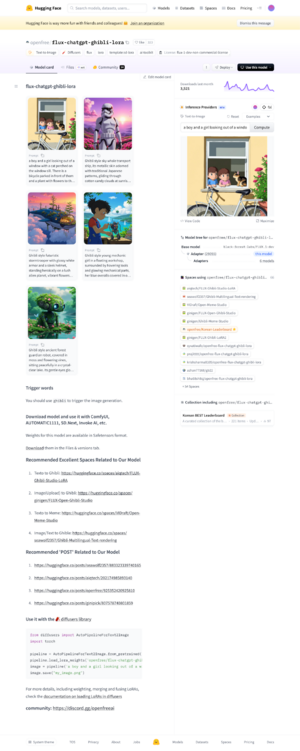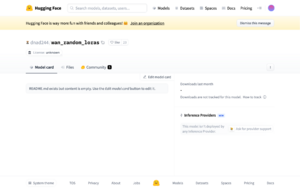Model card: Difference between revisions
From CTPwiki
| (One intermediate revision by the same user not shown) | |||
| Line 8: | Line 8: | ||
[[File:Screenshot 2025-05-23 at 12-36-05 openfree flux-chatgpt-ghibli-lora · Hugging Face.png|thumb|left|alt=A model card made by a community of manga users|A model card made by a community of manga users]] | [[File:Screenshot 2025-05-23 at 12-36-05 openfree flux-chatgpt-ghibli-lora · Hugging Face.png|thumb|left|alt=A model card made by a community of manga users|A model card made by a community of manga users]] | ||
[[File:Screenshot 2025-05-23 at 12-38-33 black-forest-labs FLUX.1-Depth-dev-lora · Hugging Face.png|thumb|left|alt=A model card made by the company Black Forest Labs|A model card made by the company Black Forest Labs]] | [[File:Screenshot 2025-05-23 at 12-38-33 black-forest-labs FLUX.1-Depth-dev-lora · Hugging Face.png|thumb|left|alt=A model card made by the company Black Forest Labs|A model card made by the company Black Forest Labs]] | ||
[[File:Screenshot 2025-05-23 at 12-36-34 dnad244 wan random loras · Hugging Face.png|thumb|left|alt=An empty model card|An empty model card]] | |||
<div style="clear:both;"></div> | |||
== What is the network that sustains this object? == | == What is the network that sustains this object? == | ||
Latest revision as of 12:50, 23 May 2025
From What's documented in AI? Systematic Analysis of 32K AI Model Cards:
Model cards have emerged as the standard approach to document AI models, inspired by the concept of food nutrition labels and datasheets in the electronics industry. They are documents that provide essential information about a model in a standardized, easy-to-understand format. At the core of these cards are sections detailing model training and validation procedures, intended uses and potential limitations such as bias and fairness analysis, and usage guidance. Compared to other documentation formats such as academic papers or technical reports, model cards are increasingly becoming a preferred reference for practitioners in the AI community for a number of reasons. First, they offer more concise, relevant, and easily understandable information about AI models, rendering them more accessible. Another important aspect of model cards is their up-to-date nature, as they can be frequently updated to reflect any changes, improvements, or new findings about the AI model. In contrast, academic papers, once published, may not be updated as regularly, which could result in outdated information. Additionally, many popular model repositories, especially those originating from industry or open-source enthusiasts, don’t have accompanying academic papers or technical reports. This further accentuates the indispensable role of model cards as a comprehensive, streamlined, and informative communication mechanism within the AI ecosystem.
Examples



What is the network that sustains this object?
- How does it move from person to person, person to software, to platform, what things are attached to it (visual culture)
- Networks of attachments
- How does it relate / sustain a collective? (human + non-human)
How does it evolve through time?
Evolution of the interface for these objects. Early chatgpt offered two parameters through the API: prompt and temperature. Today extremely complex object with all kinds of components and parameters. Visually what is the difference? Richness of the interface in decentralization (the more options, the better...)